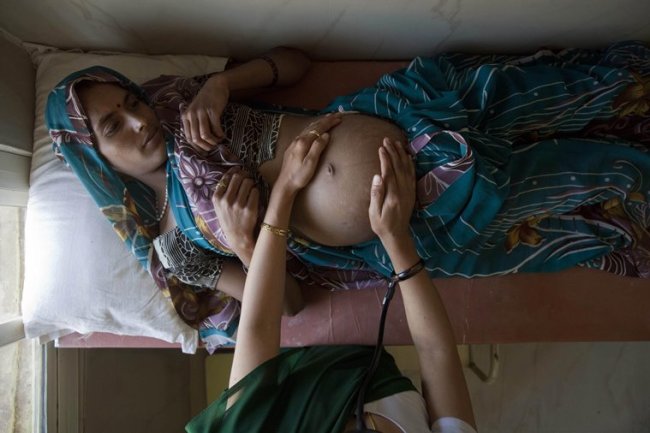Opinion Maternity (Amendment) Bill: Looks good on paper, but there’s more to it than what meets the eye
While India may be ahead of the United States (which gives its women employees 12 weeks of unpaid maternity leave), our Maternity Bill leaves out a large section of women in the unorganized sector -- and that's a colossal setback.
 "Suman, a 25-year-old pregnant woman, lies on an examination table as a nurse places her hands on her stomach during a check up at a community health centre in the remote village of Chharchh, in the central Indian state of Madhya Pradesh, February 24, 2012." *** Local Caption *** "Suman, a 25-year-old pregnant woman, lies on an examination table as a nurse places her hands on her stomach during a check up at a community health centre in the remote village of Chharchh, in the central Indian state of Madhya Pradesh, February 24, 2012. In rural Madhya Pradesh, an innovative free maternity ambulance service called ""Janani Express"", which runs in partnership between the state government and the United Nations Children's Fund (UNICEF), is trying to increase the number of babies born in clinics where proper care can be provided to the mothers and newborn children, and infant mortality can be decreased. Before this initiative, women would have been left to give birth in the fields or on mud floors. Now, the free ambulance brings pregnant women across dusty roads to health clinics where they can give birth safely under basic medical supervision, be nursed afterwards and educated on the importance of breastfeeding and hygiene before returning to their villages and communities. The United Nations' International Women's Day will be celebrated on March 8. Picture taken February 24, 2012. REUTERS/Vivek Prakash (INDIA - Tags: HEALTH SOCIETY POVERTY)"
"Suman, a 25-year-old pregnant woman, lies on an examination table as a nurse places her hands on her stomach during a check up at a community health centre in the remote village of Chharchh, in the central Indian state of Madhya Pradesh, February 24, 2012." *** Local Caption *** "Suman, a 25-year-old pregnant woman, lies on an examination table as a nurse places her hands on her stomach during a check up at a community health centre in the remote village of Chharchh, in the central Indian state of Madhya Pradesh, February 24, 2012. In rural Madhya Pradesh, an innovative free maternity ambulance service called ""Janani Express"", which runs in partnership between the state government and the United Nations Children's Fund (UNICEF), is trying to increase the number of babies born in clinics where proper care can be provided to the mothers and newborn children, and infant mortality can be decreased. Before this initiative, women would have been left to give birth in the fields or on mud floors. Now, the free ambulance brings pregnant women across dusty roads to health clinics where they can give birth safely under basic medical supervision, be nursed afterwards and educated on the importance of breastfeeding and hygiene before returning to their villages and communities. The United Nations' International Women's Day will be celebrated on March 8. Picture taken February 24, 2012. REUTERS/Vivek Prakash (INDIA - Tags: HEALTH SOCIETY POVERTY)" 
On Thursday, Parliament cleared the Maternity Benefit (Amendment) Bill 2016, an improvement on the original Act that was passed on December 12, 1961. The bill aims at providing working women maternity leave and selective benefits, before and after the birth of their child.
While the original Act laid down that expecting mothers would be provided 12 weeks of paid leave, the amended Act (http://bit.ly/2mrZxcs), pushes the number of weeks to 26. The Act is expected to benefit at least 1.8 million women. It catapults India on the world map as one of the countries with a relatively progressive and sensitive view towards working mothers who need maternity leave and benefits. India will now rank third, pitched right behind Canada (50 weeks) and Norway (44 weeks), in terms of the number of weeks a country provides for paid maternity leaves.
In fact, it is even far ahead of the United States, a country where the women’s rights movement originated back in 1848. However, even in 2017, the country gives its women employees 12 weeks of leave – that too, unpaid. The maternity leave in the United States comes under the overarching umbrella of the 1993 legislation called the Family and Medical Leave Act (http://bit.ly/2en7FnI), where employees can take leave for a wide ambit of reasons – from vacation to sickness and pregnancy. The website states: “Pregnancy disability leave or maternity leave for the birth of a child would be considered qualifying FMLA leave for a serious health condition and may be counted in the 12 weeks of leave so long as the employer properly notifies the employee in writing of the designation.” I would have apprehensions of using the term ‘pregnancy disability leave’, but let’s not go off tangent.
India’s Maternity (Amendment) Bill is a landmark bill in comparison. It also entitles women who legally adopt a child below the age of three months, as well as “commissioning mothers” to have a paid leave for a duration of 12 weeks. A commissioning mother can be described as a biological parent who uses her eggs to have children through surrogacy. In addition, the Act also lays down every company with 50 or more employees to provide a creche facility.
Now, on paper, this looks fantastic. However, there are some grave shortcomings.
First, the Maternity Bill does not cover women in the unorganised sector. Although the Bill was welcomed with open arms, the Communist Party of India’s D Raja reiterated this gap, “There are a lot of women who are working in the informal, unorganised sector. Government shouldn’t stop with this bill alone.”
A large section of working women – 90 percent according to the National Commission for Enterprises in Unorganised and Informal Sector’s 2009 report (http://bit.ly/2m9jZMs) – earn their wages in the unorganised, semi-skilled or unskilled sectors. These include agricultural labourers, domestic help, construction workers, bidi-makers, seasonal workers, tailors, tobacco-making employees and sales works, among others who work in unstructured working environments or have multiple employers. Under such employment structures, many women are not eligible for the benefits the Act provides.
Second, women employees are entitled to the benefit of a paid leave of 26 weeks only for their first two children, after which the number of paid weeks reduces to 12 weeks. Which means, the third child’s growth and development may be affected. Interestingly, in the original Maternity Bill of 1961, the paid maternity leave was applicable regardless of the number of children a woman employee had.
Third, while the Maternity (Amendment) Bill would be advantageous for women belonging to essentially the private, organised sectors, the government’s overall approach towards pregnant women is still not too sensitive. The Maternity Benefit programme (http://bit.ly/2m6BXyu), for instance, which provides financial assistance to expecting mothers, will now be restricted to the firstborn only.
The Maternity Benefit Programme is an incentive for pregnant and lactating women. It was introduced for “(i) the wage loss so that the woman can take adequate rest before and after delivery; (ii) to improve her health and nutrition during the period of pregnancy and lactation; and (iii) to breastfeed the child during the first six months of the birth, which is very vital for the development of the child”. However, if financial aid is limited to only the first child, underprivileged women who are expecting their second or third child would suffer tremendously.
Recently, there has also been a heightened demand for paternity leave. When the Rajya Sabha passed the Maternity Benefit (Amendment) Bill in 2016, there were many who voiced a need for paternity leave. However, Women and Child Development Minister Maneka Gandhi had snarled at that time saying that men would take disadvantage of the paternity benefit. She told The Indian Express that, “Paternity leave can be considered only if, once the woman goes back to work after her 26 weeks of leave, we find that men are availing their sick leave for a month to take care of the child. Let me see how many men do that. I will be happy to give it but for a man, it will be just a holiday, he won’t do anything.” She further added that she would consider the leave provision in the Bill, if she learned that the men were taking one-month long ‘sick leaves’ to look after their children.
While the government has made a fundamental move in increasing the number of weeks to the maternity leave, it hasn’t gone the whole nine yards to provide sufficient aid to women who are expecting. The government would do well to work towards narrowing this gap in coming legislation.




